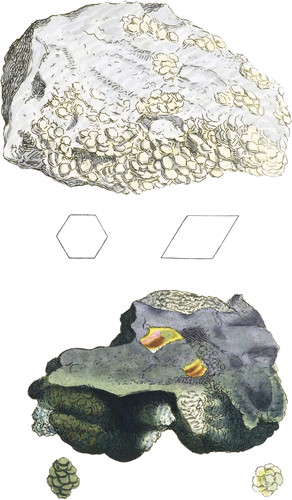 Enlarge
Enlarge
British Mineralogy
Talc
- Div. 1. Crystallized.
- Syn.
- Talc, Venetian Talc. Kirwan, v. 1. 150.
- Talc. Haüy, t. 3. 252.
- Chlorite. Kirwan, v. 1. 147.
- Talcum viridans. T. lamellare, and many others. Linn. ed. 13. t. 3. 51 et seq.
- Mica Talcosa. Ibid. t. 3. 59.
- Talk. Emmerling, t. 1. 391.
Chlorite is not a scientific name, according to our present improvements in mineralogical knowledge, as it is perfectly confined to a green variety of Talc, found either in small laminated crystals, granular fragments or masses, or disseminated through (Quartz, &c. Its grain is sometimes very fine, I find in this latter state it is scarcely known by any one, as any green earthy substance may be confounded with it. Talc and Mica, as observed under tab. 180, have been till lately much confounded; but since the publication of Mr. Kirwan’s excellent work they have been more and more defined.
The upper specimen came from Stenna-Gwyn in Cornwall, where it is found in abundance, often holding Phosphate of Lime, among Quartz, and decomposing Feltspar; whence the rock itself is often called Apatite, the old name for Phosphate of Lime, Abundance of Oxide of Tin often accompanies it. This is a variety of Talc, agreeing with that called Chlorite in every external character except colour, which instead of being green is that of cream.
The lower specimen has the colour most usually allotted to Chlorite, which is undoubtedly to be attributed to a large adventitious mixture of Iron, which at the same time renders it easily fusible.
Mica and Talc seem to have the same forms in their Crystals, but they are never by any means so large or well defined in Talc. These Crystals are remarkably soapy or greasy to the touch, particularly if bruised. The laminæ are very easilv broken, and are apt to divide into minute greasy scales; which property has rendered this fossil an ingredient in cosmetics. The white varieties are difficultly fusible.
White Talc analysed by Hoepfner was found to contain:
| Silex | 50 |
| Magnesia | 44 |
| Argil | 6 |
| 100 |
| Silica | 26.0 |
| Argilla | 18.5 |
| Magnesia | 8.0 |
| Oxide of Iron | 43.0 |
| Muriate of Soda and Potash | 2.0 |
| Water | 2.0 |
| Loss | 0.5 |
| 100.0 |

